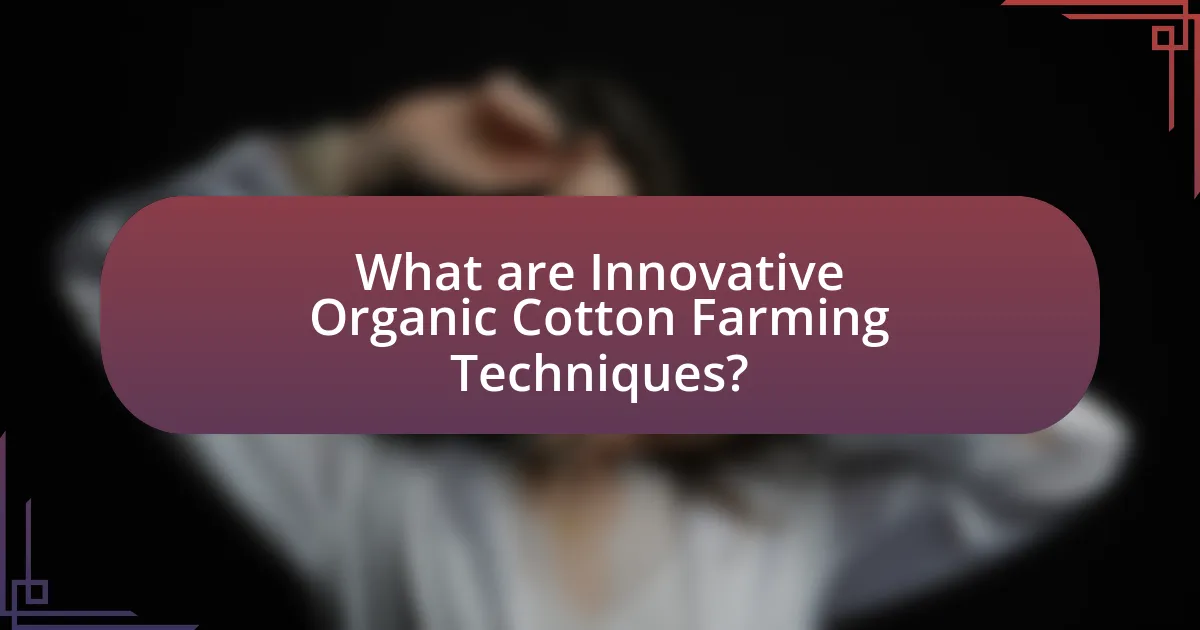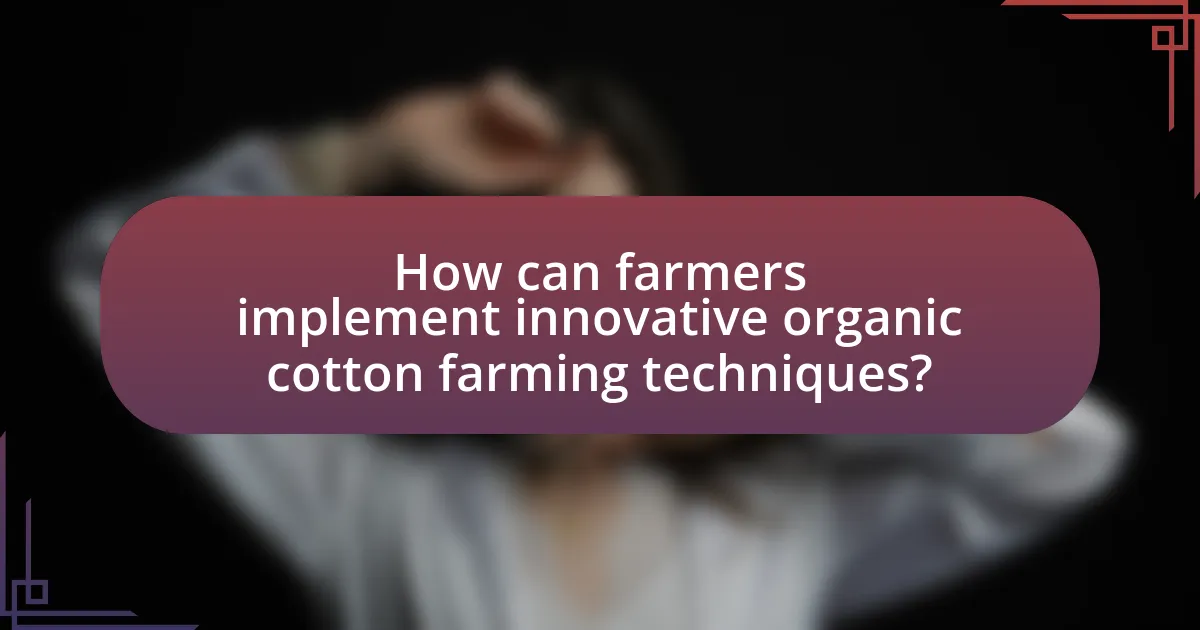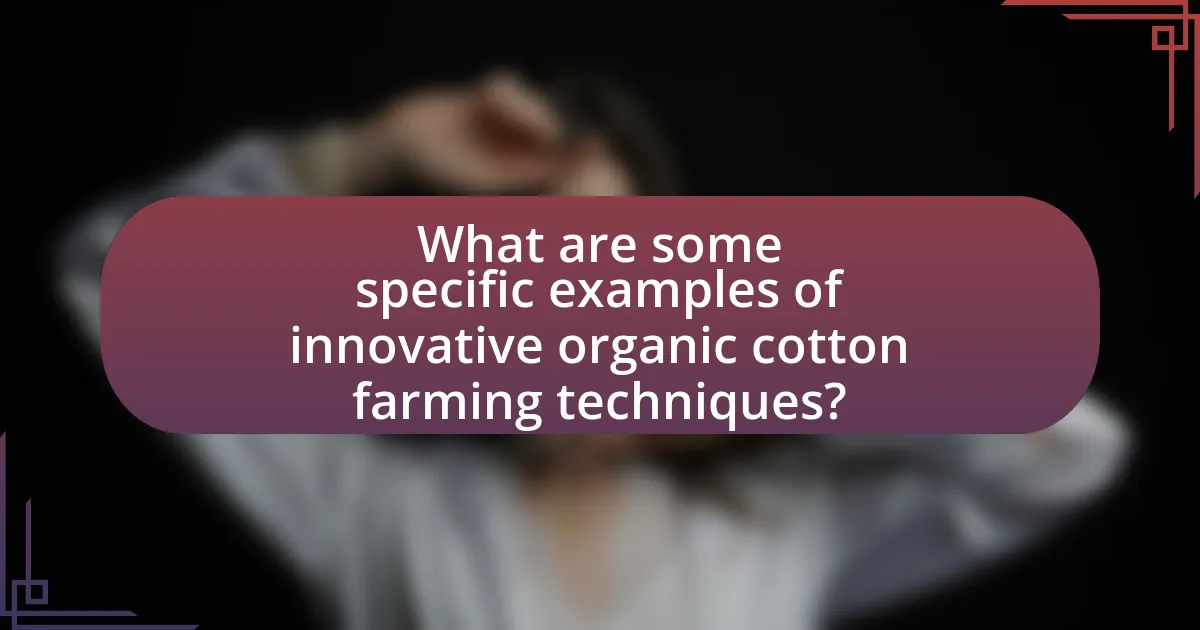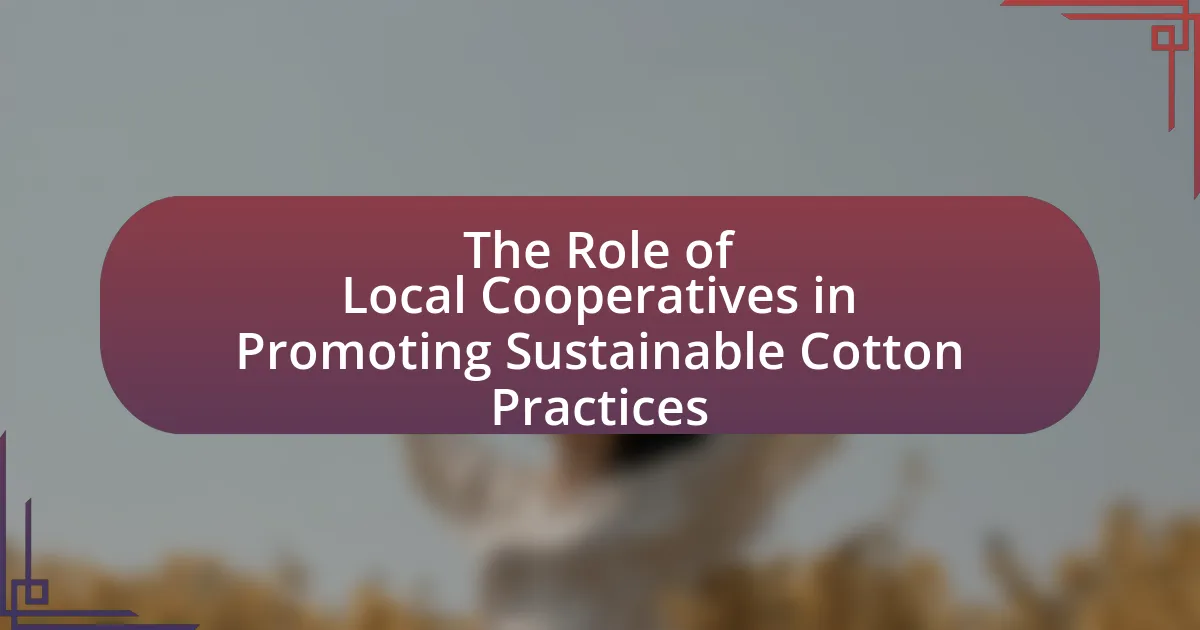Innovative organic cotton farming techniques focus on sustainable practices that enhance productivity while minimizing environmental impact. Key methods include intercropping, crop rotation, and the use of bio-pesticides, which improve soil health, reduce pest pressure, and promote biodiversity. These techniques differ from traditional methods by emphasizing natural inputs over synthetic chemicals, leading to increased yields and lower water usage. The article explores the benefits of these practices, such as improved soil fertility and economic viability for farmers, as well as the challenges and resources available for transitioning to organic methods. Additionally, it highlights the role of technology and data analytics in optimizing organic cotton production.

What are Innovative Organic Cotton Farming Techniques?
Innovative organic cotton farming techniques include practices such as intercropping, crop rotation, and the use of bio-pesticides. Intercropping involves planting cotton alongside other crops to enhance biodiversity and reduce pest pressure, which can lead to higher yields and improved soil health. Crop rotation helps in breaking pest and disease cycles, while also enhancing soil fertility through the incorporation of different plant nutrients. The application of bio-pesticides, derived from natural materials, minimizes chemical inputs and promotes a healthier ecosystem. These techniques have been shown to increase organic cotton production sustainably, as evidenced by studies indicating that organic farming can yield comparable or even higher outputs than conventional methods while preserving environmental integrity.
How do these techniques differ from traditional cotton farming methods?
Innovative organic cotton farming techniques differ from traditional cotton farming methods primarily in their approach to sustainability and chemical usage. Traditional methods often rely on synthetic fertilizers and pesticides, which can harm the environment and reduce soil health. In contrast, innovative organic techniques emphasize natural inputs, such as compost and biological pest control, promoting biodiversity and soil fertility. For example, organic cotton farming practices have been shown to reduce water usage by up to 50% compared to conventional methods, as reported by the Textile Exchange in their 2021 Organic Cotton Market Report. This shift not only enhances ecological balance but also improves the long-term viability of cotton production.
What specific practices are considered innovative in organic cotton farming?
Innovative practices in organic cotton farming include crop rotation, intercropping, and the use of cover crops. Crop rotation enhances soil fertility and disrupts pest cycles, while intercropping with legumes can improve nitrogen levels in the soil. The implementation of cover crops prevents soil erosion and enhances biodiversity. Research indicates that these practices can lead to increased yields and improved soil health, as demonstrated in studies by the International Cotton Advisory Committee, which highlight the benefits of sustainable farming techniques in organic cotton production.
Why is it important to adopt innovative techniques in organic cotton farming?
Adopting innovative techniques in organic cotton farming is crucial for enhancing sustainability and productivity. These techniques, such as precision agriculture and integrated pest management, improve resource efficiency and reduce environmental impact. For instance, a study published in the Journal of Cleaner Production found that precision farming can increase yields by up to 20% while minimizing water usage by 30%. This demonstrates that innovative practices not only support ecological balance but also contribute to economic viability for farmers.
What are the key benefits of using innovative organic cotton farming techniques?
Innovative organic cotton farming techniques offer several key benefits, including improved soil health, reduced environmental impact, and enhanced economic viability for farmers. These techniques, such as crop rotation and integrated pest management, promote biodiversity and reduce reliance on synthetic fertilizers and pesticides, leading to healthier ecosystems. Research indicates that organic cotton farming can increase soil organic matter by up to 30%, which enhances soil fertility and water retention. Additionally, organic cotton production has a lower carbon footprint, with studies showing that it can reduce greenhouse gas emissions by 46% compared to conventional methods. These benefits contribute to sustainable agricultural practices and support the livelihoods of farmers by providing access to premium markets for organic products.
How do these techniques contribute to environmental sustainability?
Innovative organic cotton farming techniques contribute to environmental sustainability by reducing chemical inputs and enhancing soil health. These techniques, such as crop rotation, cover cropping, and integrated pest management, minimize the reliance on synthetic fertilizers and pesticides, which can harm ecosystems. For instance, studies show that organic cotton farming can reduce water usage by up to 90% compared to conventional methods, thereby conserving vital water resources. Additionally, organic practices improve soil fertility and biodiversity, leading to healthier ecosystems that can better withstand climate change impacts.
What economic advantages do farmers gain from adopting these methods?
Farmers gain significant economic advantages from adopting innovative organic cotton farming techniques, primarily through reduced input costs and increased market prices for organic products. By utilizing methods such as crop rotation, cover cropping, and integrated pest management, farmers can lower their reliance on synthetic fertilizers and pesticides, leading to decreased operational expenses. Additionally, organic cotton typically commands a premium price in the market, with organic cotton prices averaging 20-30% higher than conventional cotton prices, enhancing overall profitability. This combination of lower costs and higher revenue contributes to improved financial sustainability for farmers engaged in organic practices.

How can farmers implement innovative organic cotton farming techniques?
Farmers can implement innovative organic cotton farming techniques by adopting practices such as crop rotation, intercropping, and the use of organic pest management. Crop rotation helps maintain soil fertility and disrupts pest cycles, while intercropping can enhance biodiversity and reduce the risk of crop failure. Organic pest management techniques, including the use of beneficial insects and natural repellents, minimize chemical inputs and promote ecological balance. Research indicates that these methods can lead to higher yields and improved soil health, as demonstrated in studies conducted by the International Cotton Advisory Committee, which found that organic practices can increase soil organic matter by up to 30%.
What steps should farmers take to transition to innovative organic practices?
Farmers should adopt a systematic approach to transition to innovative organic practices by first conducting a thorough assessment of their current farming methods. This assessment should identify areas where organic practices can be integrated, such as soil health improvement, pest management, and crop rotation. Next, farmers should educate themselves on organic farming principles and techniques, which can include attending workshops, consulting with organic farming experts, and accessing resources from agricultural extension services.
Implementing cover cropping and composting can enhance soil fertility and structure, while integrated pest management strategies can reduce reliance on synthetic pesticides. Additionally, farmers should gradually convert their fields to organic by following the USDA organic certification process, which requires a three-year transition period without prohibited substances.
Evidence from the Rodale Institute indicates that organic farming can increase soil health and biodiversity, leading to improved crop yields over time. By following these steps, farmers can effectively transition to innovative organic practices that promote sustainability in cotton farming.
What resources are available to support farmers in this transition?
Farmers transitioning to innovative organic cotton farming techniques can access various resources, including government grants, educational programs, and agricultural extension services. Government grants, such as those provided by the USDA’s Organic Certification Cost Share Program, help offset the costs of organic certification and transition. Educational programs offered by universities and agricultural organizations provide training on sustainable practices, pest management, and soil health. Additionally, agricultural extension services offer personalized support and resources tailored to local conditions, helping farmers implement effective organic farming techniques. These resources collectively facilitate the transition to sustainable production methods in organic cotton farming.
How can farmers measure the success of their innovative practices?
Farmers can measure the success of their innovative practices by evaluating key performance indicators such as yield improvements, cost reductions, and environmental impact. For instance, a study published in the Journal of Sustainable Agriculture found that farmers implementing precision agriculture techniques saw a 20% increase in cotton yield while reducing water usage by 30%. Additionally, farmers can assess soil health and biodiversity metrics to determine the ecological benefits of their practices. These quantifiable metrics provide concrete evidence of the effectiveness of innovative methods in organic cotton farming.
What challenges might farmers face when adopting these techniques?
Farmers may face several challenges when adopting innovative organic cotton farming techniques, including higher initial costs, lack of knowledge, and market access issues. The transition to organic practices often requires investment in new equipment and training, which can strain financial resources. Additionally, many farmers may lack access to information or training on these techniques, leading to difficulties in implementation. Furthermore, organic cotton often faces market access challenges due to limited demand or competition from conventional cotton, making it harder for farmers to sell their products at profitable prices. These factors collectively hinder the adoption of sustainable practices in organic cotton farming.
How can farmers overcome common obstacles in organic cotton farming?
Farmers can overcome common obstacles in organic cotton farming by implementing integrated pest management (IPM) strategies, utilizing cover crops, and adopting crop rotation practices. IPM helps manage pests through biological control, reducing reliance on chemical pesticides, which is crucial in organic farming. Cover crops improve soil health and suppress weeds, enhancing crop resilience. Crop rotation disrupts pest and disease cycles, leading to healthier cotton plants. Research indicates that these practices can increase yields and sustainability, as demonstrated in studies showing that farms using IPM and cover crops reported up to a 30% increase in cotton yield compared to conventional methods.
What role do government policies play in supporting innovative practices?
Government policies play a crucial role in supporting innovative practices by providing funding, regulatory frameworks, and incentives that encourage research and development. For instance, policies that offer grants or subsidies for sustainable agricultural practices can significantly lower the financial barriers for farmers adopting innovative organic cotton farming techniques. Additionally, regulations that promote environmentally friendly practices can create a market demand for sustainable products, further incentivizing innovation. Evidence of this can be seen in the European Union’s Common Agricultural Policy, which allocates billions in support for sustainable farming initiatives, thereby fostering innovation in agricultural practices across member states.

What are some specific examples of innovative organic cotton farming techniques?
Innovative organic cotton farming techniques include intercropping, which involves planting cotton alongside other crops to enhance biodiversity and soil health. This method reduces pest pressure and improves nutrient availability. Another technique is the use of cover crops, such as legumes, which fix nitrogen in the soil, enhancing fertility and reducing the need for synthetic fertilizers. Additionally, precision agriculture technologies, like soil moisture sensors and drone monitoring, optimize water usage and crop management, leading to more efficient farming practices. These techniques have been shown to increase yields and promote sustainable farming, as evidenced by studies indicating that intercropping can lead to a 20-30% increase in cotton yields while reducing pesticide use.
How does crop rotation enhance organic cotton farming?
Crop rotation enhances organic cotton farming by improving soil health and reducing pest populations. This agricultural practice involves alternating the types of crops grown in a specific area over time, which helps maintain nutrient balance in the soil and prevents the depletion of specific nutrients that cotton requires. For instance, legumes can fix nitrogen in the soil, enriching it for subsequent cotton crops. Additionally, rotating crops disrupts the life cycles of pests and diseases that target cotton, leading to lower reliance on organic pesticides. Research indicates that farms employing crop rotation can see a 10-20% increase in yield compared to monoculture systems, demonstrating its effectiveness in sustainable organic cotton production.
What benefits does intercropping provide in organic cotton production?
Intercropping in organic cotton production enhances biodiversity, improves soil health, and increases pest control. By planting multiple crops together, farmers can create a more resilient ecosystem that supports beneficial insects and reduces the prevalence of pests. Research indicates that intercropping can lead to a 20-30% increase in yield compared to monoculture systems, as diverse plant species can utilize resources more efficiently and reduce competition for nutrients. Additionally, intercropping promotes soil fertility through the incorporation of legumes, which fix nitrogen, thereby reducing the need for synthetic fertilizers.
How can cover cropping improve soil health for cotton farming?
Cover cropping can significantly improve soil health for cotton farming by enhancing soil structure, increasing organic matter, and promoting biodiversity. Cover crops, such as legumes and grasses, prevent soil erosion, improve water retention, and enhance nutrient cycling. Research indicates that cover crops can increase soil organic carbon levels by 0.5 to 1.0 tons per hectare annually, which contributes to better soil fertility and microbial activity. Additionally, the roots of cover crops help to aerate the soil and create channels for water infiltration, reducing compaction and improving root growth for cotton plants.
What technological advancements are being utilized in organic cotton farming?
Technological advancements in organic cotton farming include precision agriculture, biotechnology, and sustainable pest management systems. Precision agriculture utilizes GPS and data analytics to optimize planting, irrigation, and harvesting, leading to increased efficiency and reduced resource use. Biotechnology, such as the development of organic seeds with improved resistance to pests and diseases, enhances crop yields without synthetic chemicals. Sustainable pest management systems, including integrated pest management (IPM) techniques, combine biological controls and natural pesticides to minimize environmental impact while maintaining crop health. These advancements collectively contribute to more sustainable and productive organic cotton farming practices.
How do precision agriculture tools aid in organic cotton production?
Precision agriculture tools enhance organic cotton production by optimizing resource use and improving crop management. These tools, such as GPS-guided equipment and remote sensing technologies, allow farmers to monitor soil health, moisture levels, and pest populations in real-time. For instance, precision irrigation systems can deliver water directly to the root zone, reducing water waste and ensuring that organic cotton plants receive the necessary hydration without over-irrigation. Additionally, data analytics from these tools help in making informed decisions regarding planting schedules and nutrient applications, which are crucial for maintaining organic standards. Studies have shown that farms utilizing precision agriculture can increase yields by up to 20% while minimizing environmental impact, thus supporting sustainable production practices in organic cotton farming.
What role does data analytics play in optimizing organic cotton farming techniques?
Data analytics plays a crucial role in optimizing organic cotton farming techniques by enabling farmers to make data-driven decisions that enhance crop yield and sustainability. By analyzing data from various sources such as soil health, weather patterns, and pest populations, farmers can tailor their farming practices to specific conditions, leading to improved resource management. For instance, a study published in the journal “Agricultural Systems” found that data analytics can increase cotton yields by up to 20% through precision agriculture techniques, which utilize real-time data to optimize planting schedules and irrigation practices. This evidence demonstrates that data analytics not only supports better farming decisions but also contributes to the overall sustainability of organic cotton production.
What best practices should farmers follow for successful organic cotton production?
Farmers should implement crop rotation, use organic pest management, and maintain soil health for successful organic cotton production. Crop rotation helps prevent pest buildup and improves soil fertility by alternating cotton with legumes or other crops. Organic pest management involves using natural predators and biopesticides, which reduces reliance on synthetic chemicals and promotes biodiversity. Maintaining soil health through practices like composting and cover cropping enhances nutrient availability and soil structure, leading to better cotton yields. Research indicates that these practices can increase organic cotton yields by up to 30% compared to conventional methods, demonstrating their effectiveness in sustainable production.
How can farmers ensure soil fertility in organic cotton farming?
Farmers can ensure soil fertility in organic cotton farming by implementing crop rotation, cover cropping, and the use of organic amendments. Crop rotation helps break pest and disease cycles while enhancing soil structure and nutrient availability. Cover cropping, such as planting legumes, adds nitrogen to the soil and prevents erosion. Organic amendments, including compost and manure, enrich the soil with essential nutrients and improve microbial activity. Research indicates that these practices can significantly enhance soil health and fertility, leading to improved cotton yields and sustainability in organic farming systems.
What pest management strategies are effective in organic cotton cultivation?
Effective pest management strategies in organic cotton cultivation include the use of biological control agents, crop rotation, and the implementation of integrated pest management (IPM) practices. Biological control agents, such as beneficial insects like ladybugs and parasitic wasps, help to naturally reduce pest populations. Crop rotation disrupts pest life cycles and reduces the buildup of pest populations in the soil. IPM combines various strategies, including monitoring pest populations and using organic pesticides when necessary, to manage pests sustainably. Research indicates that these methods can significantly reduce pest damage while maintaining ecological balance, making them essential for successful organic cotton farming.





